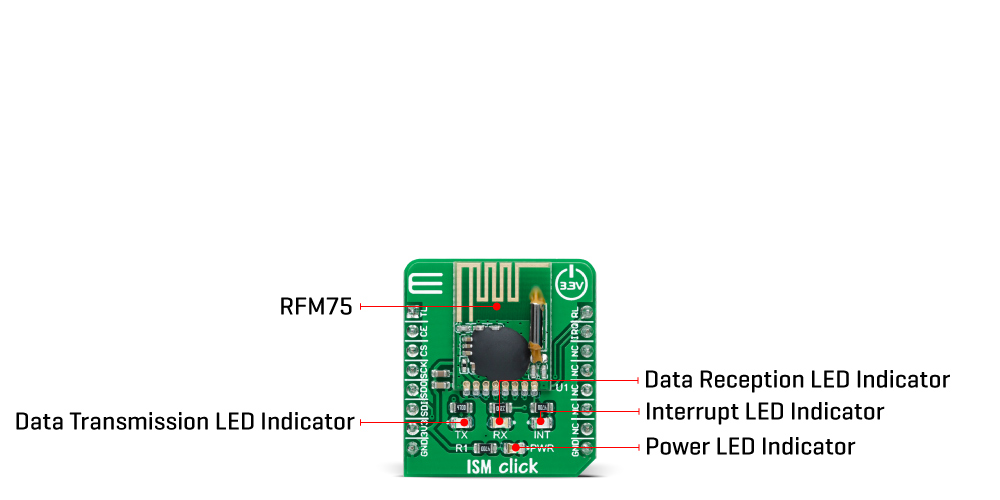OFF
GO LOCAL
| Company | Stock | Price |
|---|---|---|

MIKROE-4625
17 g
Status:
ISM Click is a compact add-on board that contains a complete wireless RF digital data transceiver. This board features the RFM75, a low-power, high-performance 2.4GHz GFSK transceiver from RF Solutions. The RFM75 transceiver is configurable through SPI serial interface and operates with only 3.3V in the worldwide ISM frequency band from 2400MHz up to 2527MHz. The embedded packet processing engines enable their entire operation with a simple MCU as a radio system. Burst mode transmission and up to 2Mbps air data rate make it suitable for applications requiring ultra-low power consumption. This Click board™ is ideal for home appliances, remote control applications, consumer electronics, and many more.
ISM Click is supported by a mikroSDK compliant library, which includes functions that simplify software development. This Click board™ comes as a fully tested product, ready to be used on a system equipped with the mikroBUS™ socket.
This product is no longer in stock
Availability date:
OFF
| Company | Stock | Price |
|---|---|---|

ISM Click as its foundation uses the RFM75, a low-power, high-performance 2.4GHz GFSK transceiver operating in the worldwide ISM frequency band from 2400MHz up to 2527MHz from RF Solutions. The RFM75 operates in TDD mode, either as a transmitter or as a receiver. Burst mode transmission and up to 2Mbps air data rate make it suitable for applications requiring ultra-low power consumption. The embedded packet processing engines enable their entire operation with a simple MCU as a radio system. Auto re-transmission and auto acknowledge giving reliable link without any MCU interference.

A transmitter and a receiver must be programmed with the same RF channel frequency to communicate with each other supporting a programmable air data rate of 250Kbps, 1Mbps, or 2Mbps. The RF channel frequency determines the center of the channel used by RFM75. The RF_CH register, in register bank 0, sets the frequency according to the following formula F0= 2400 + RF_CH (MHz), where the resolution of the RF channel frequency is 1MHz.
ISM Click communicates with MCU using the standard SPI serial interface that operates at clock rates up to 8 MHz. In power-down mode, RFM75 is in Sleep mode with minimal current consumption. SPI interface is still active in this mode, and all register values are available by SPI interface. This Click board™ also has a yellow LED indicator routed on the INT pin of the mikroBUS™ socket (provide the user with feedback after a successfully received package) and chip-enable function routed on the RST pin of the mikroBUS™ which activates TX or RX mode of the RFM75. Besides, it also has two additional LED indicators, a red and blue LED routed on the AN and PWM pins of the mikroBUS™ socket. The user can use it for visual indication when sending or receiving data.
This Click board™ can be operated only with a 3.3V logic voltage level. The board must perform appropriate logic voltage level conversion before use with MCUs with different logic levels. However, the Click board™ comes equipped with a library containing functions and an example code that can be used, as a reference, for further development.
Type
2.4 GHz Transceivers
Applications
Can be used for home appliances, remote control applications, consumer electronics, and many more.
On-board modules
RFM75 - low-power, high-performance 2.4GHz GFSK transceiver operating in the worldwide ISM frequency band from 2400MHz up to 2483.5MHz from RF Solutions
Key Features
Low power consumption, 2400-2483.5 MHz ISM band operation, support 250Kbps, 1Mbps and 2 Mbps air data rate, automatic packet processing, high performance, SPI interface, and more.
Interface
SPI
Feature
No ClickID
Compatibility
mikroBUS™
Click board size
S (28.6 x 25.4 mm)
Input Voltage
3.3V
This table shows how the pinout on ISM Click corresponds to the pinout on the mikroBUS™ socket (the latter shown in the two middle columns).
| Label | Name | Default | Description |
|---|---|---|---|
| LD1 | PWR | - | Power LED Indicator |
| LD2 | INT | - | Interrupt LED Indicator |
| LD3 | TX | - | Data Transmission LED Indicator |
| LD4 | RX | - | Data Reception LED Indicator |
| Description | Min | Typ | Max | Unit |
|---|---|---|---|---|
| Supply Voltage | - | 3.3 | - | V |
| Operating Frequency Range | 2400 | - | 2527 | MHz |
| Air Data Rate | 250 | - | 2000 | Kbps |
| Operating Temperature Range | -40 | +25 | +85 | °C |
We provide a library for the ISM Click as well as a demo application (example), developed using MikroElektronika compilers. The demo can run on all the main MikroElektronika development boards.
Package can be downloaded/installed directly from NECTO Studio Package Manager(recommended way), downloaded from our LibStock™ or found on mikroE github account.
Library Description
This library contains API for ISM Click driver.
Key functions:
ism_cfg_setup - Config Object Initialization function.ism_init - Initialization function.ism_default_cfg - Click Default Configuration function.Examples description
This library contains API for the ISM Click driver. This example transmits/receives and processes data from ISM clicks. The library initializes and defines the UART bus drivers to transmit or receive data.
The demo application is composed of two sections :
void application_task ( void ) {
#ifdef RECEIVER
uint8_t rx_buf[ ISM_MAX_PACKET_LEN ] = { 0 };
ism_receive_packet( &ism, &rx_buf[ 0 ] );
if ( rx_buf[ 0 ] != 0 ) {
log_printf( &logger, " Rx : %s", rx_buf );
}
#endif
#ifdef TRANSMITTER
ism_transmit_packet( &ism, ISM_CMD_W_TX_PAYLOAD_NOACK, &demo_message_1[ 0 ], 9 );
log_printf( &logger, " Tx : %s", demo_message_1 );
Delay_ms( 1000 );
ism_transmit_packet( &ism, ISM_CMD_W_TX_PAYLOAD_NOACK, &demo_message_2[ 0 ], 12 );
log_printf( &logger, " Tx : %s", demo_message_2 );
Delay_ms( 1000 );
#endif
}
The full application code, and ready to use projects can be installed directly from NECTO Studio Package Manager(recommended way), downloaded from our LibStock™ or found on mikroE github account.
Other mikroE Libraries used in the example:
Additional notes and informations
Depending on the development board you are using, you may need USB UART click, USB UART 2 click or RS232 click to connect to your PC, for development systems with no UART to USB interface available on the board. The terminal available in all MikroElektronika compilers, or any other terminal application of your choice, can be used to read the message.
This Click board™ is supported with mikroSDK - MikroElektronika Software Development Kit. To ensure proper operation of mikroSDK compliant Click board™ demo applications, mikroSDK should be downloaded from the LibStock and installed for the compiler you are using.
For more information about mikroSDK, visit the official page.
NOTE: Please be advised that any peripheral devices or accessories shown connected to the Click board™ are not included in the package. Check their availability in our shop or in the YMAN section below.